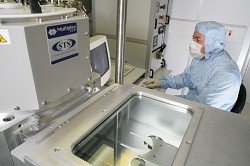New materials improve laboratory-on-a-chip integration
Nanoantennas integrated onto silicon chips can be used to identify the presence of specific molecules in medical diagnostics, in the detection of explosives or to identify polluting substances in the environment. Individual molecules have their own characteristic set of vibration frequencies, a ‘fingerprint’ that can be detected by illuminating a substance using infrared light. Nanoscale conductive metal objects act as antennas that capture and focus the light to amplify the signal generated by tiny amounts of molecules. Currently these microscopic antennas are made of metals, usually gold because of its excellent conductive properties. Now EU-funded scientists under the GEMINI project (Germanium mid-Infrared Plasmonics for Sensing) have looked into using new materials such as germanium, which is close to silicon on the periodic table, to replace gold in infrared sensing. The consortium included Politecnico di Milano and Sapienza University of Rome, in Italy, the University of Glasgow in the UK, and the University of Konstanz in Germany. ‘Germanium is a semiconductor that is fully compatible with silicon-based manufacturing processes,’ says project coordinator Paolo Biagioni, associate professor of physics at the Politecnico di Milano, Italy and an expert in plasmonics, the field of science that uses metals to build nanoscale antenna systems for light. The ultimate aim is to integrate the automated sensing devices for harmful substances in laboratory-on-a-chip biosensors. However as metal-based antennas are not compatible with mainstream silicon manufacturing processes, they cannot be fully integrated with silicon chip semiconductor production lines for a low-cost manufacturing process. Imitating metal However, ‘if you engineer a semiconductor material, such as germanium, using what scientists call ‘doping’ — adding different atomic species inside the material, in our case, phosphorus — you can make the semiconductor act as a metal at optical frequencies,’ says Professor Biagioni. Although achieving this is challenging for the visible light spectrum, ‘because of our project, it is now possible to grow semiconductors that mimic metals in the infrared,’ he adds. Silicon wafers used in the microelectronic industry are covered with a thin ‘doped’ germanium film and then nanoantennas are etched into the germanium layer. ‘We achieved record values in the levels of doping for germanium,’ he says ‘so that now we can safely say it is a viable alternative to metals for infrared antennas.’ Detection applications Sensing in the mid-infrared can target gases in the atmosphere or analytes in a solution with high molecule specificity. While the GEMINI project was largely fundamental research, not aimed at producing specific detecting devices, the team also focused on two main applications — the detection of explosive simulants in liquid form and the detection of DNA chains in a solution. With explosives, the team reached proof of concept stage. ‘In the case of DNA sensing, with infrared light you can tell different types of DNA strains from each other. For example, there are single-stranded and double-stranded DNA’ and you need to detect the relative concentration of each, he notes. This could have exciting implications for one-chip medical diagnostics and for the detection of some environmental pollutants.







